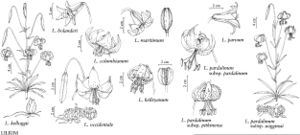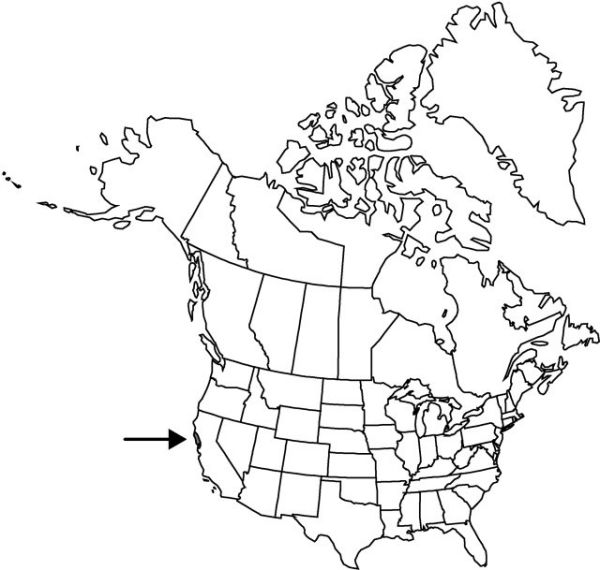Difference between revisions of "Lilium maritimum"
Proc. Calif. Acad. Sci. 6: 140. 1875.
FNA>Volume Importer |
imported>Volume Importer |
||
| (6 intermediate revisions by 2 users not shown) | |||
| Line 8: | Line 8: | ||
}} | }} | ||
|common_names=Coast lily | |common_names=Coast lily | ||
| + | |special_status={{Treatment/ID/Special_status | ||
| + | |code=F | ||
| + | |label=Illustrated | ||
| + | }}{{Treatment/ID/Special_status | ||
| + | |code=E | ||
| + | |label=Endemic | ||
| + | }}{{Treatment/ID/Special_status | ||
| + | |code=C | ||
| + | |label=Conservation concern | ||
| + | }} | ||
|basionyms= | |basionyms= | ||
|synonyms= | |synonyms= | ||
| Line 25: | Line 35: | ||
|distribution=Calif. | |distribution=Calif. | ||
|discussion=<p>Of conservation concern.</p><!-- | |discussion=<p>Of conservation concern.</p><!-- | ||
| − | --><p>Lilium maritimum is known in California from below San Francisco to about Westport in Mendocino County, and invariably grows within a few miles of the ocean. The coast lily has suffered grave declines in the past century and has been extirpated from the southern part of its range. The recent rediscovery of a population in Marin County at Point Reyes National Seashore is heartening, but development of coastal prairie farther north continues to be a threat.</p><!-- | + | --><p><i>Lilium maritimum</i> is known in California from below San Francisco to about Westport in Mendocino County, and invariably grows within a few miles of the ocean. The coast lily has suffered grave declines in the past century and has been extirpated from the southern part of its range. The recent rediscovery of a population in Marin County at Point Reyes National Seashore is heartening, but development of coastal prairie farther north continues to be a threat.</p><!-- |
| − | --><p>The combination of nodding habit and campanulate perianth with rolled sepal and petal tips is unique among the North American lilies. Hybrids with Lilium pardalinum are known; these can be clonal and their flowers are morphologically intermediate between the parents.</p><!-- | + | --><p>The combination of nodding habit and campanulate perianth with rolled sepal and petal tips is unique among the North American lilies. Hybrids with <i>Lilium pardalinum</i> are known; these can be clonal and their flowers are morphologically intermediate between the parents.</p><!-- |
| − | --><p>Lilium maritimum is pollinated sequentially, first by Allen’s [Selasphorus sassin (Lesson), family Trochilidae] and Anna’s hummingbirds [Calypte anna (Lesson)], and later in the blooming cycle by several different bumblebees (Bombus Latrielle, family Apidae).</p> | + | --><p><i>Lilium maritimum</i> is pollinated sequentially, first by Allen’s [Selasphorus sassin (Lesson), family Trochilidae] and Anna’s hummingbirds [Calypte anna (Lesson)], and later in the blooming cycle by several different bumblebees (Bombus Latrielle, family Apidae).</p> |
|tables= | |tables= | ||
|references= | |references= | ||
| Line 36: | Line 46: | ||
-->{{#Taxon: | -->{{#Taxon: | ||
name=Lilium maritimum | name=Lilium maritimum | ||
| − | |||
|authority=Kellogg | |authority=Kellogg | ||
|rank=species | |rank=species | ||
| Line 50: | Line 59: | ||
|publication title=Proc. Calif. Acad. Sci. | |publication title=Proc. Calif. Acad. Sci. | ||
|publication year=1875 | |publication year=1875 | ||
| − | |special status= | + | |special status=Illustrated;Endemic;Conservation concern |
| − | |source xml=https:// | + | |source xml=https://bitbucket.org/aafc-mbb/fna-data-curation/src/2e0870ddd59836b60bcf96646a41e87ea5a5943a/coarse_grained_fna_xml/V26/V26_316.xml |
|genus=Lilium | |genus=Lilium | ||
|species=Lilium maritimum | |species=Lilium maritimum | ||
Latest revision as of 21:14, 5 November 2020
Bulbs rhizomatous, often irregular, unbranched, continuously scaly, 1.8–4.1 × 3–7.4 cm, 0.3–0.9 times taller than long; scales usually unsegmented, a few 2-segmented, longest 1.5–3.8 cm; stem roots absent. Stems to 1.2(–2.3) m, plants on coastal bluffs shorter than 0.25 m. Buds rounded in cross section. Leaves sometimes concentrated proximally, scattered or usually in 1–3 whorls or partial whorls, 3–17 leaves per whorl, horizontal and drooping at tips to ascending, 3.6–17.7 × 0.3–4.7 cm, 2.4–18 times longer than wide; blade elliptic, sometimes narrowly so, rarely weakly oblanceolate or obovate, margins not undulate, apex acute or narrowly so; veins and margins ± smooth abaxially. Inflorescences racemose, 1–13-flowered. Flowers nodding, rarely horizontal, not fragrant; perianth campanulate; sepals and petals reflexed or rolled 1/2–4/5 along length from base, red or red-orange, with maroon spots concentrated proximally along longitudinal median and surrounded by light orange or occasionally yellow-green, not distinctly clawed; sepals not ridged abaxially, 3.4–5 × 0.9–1.3 cm; petals 3.5–5 × 0.9–1.3 cm; stamens included; filaments somewhat spreading, diverging 3°–14° from axis; anthers light magenta, 0.4–1.2 cm; pollen orange; pistil 2.2–3.2 cm; ovary 1–1.8 cm; style green; pedicel 6.3–32 cm. Capsules 2.4–4.1 × 1.2–2 cm, 1.5–2.4 times longer than wide. Seeds 120–237. 2n = 24.
Phenology: Flowering summer (late May–Jul).
Habitat: Coastal prairies, north coastal scrub, sundew (Drosera spp.) bogs, gaps in closed-cone pine forests
Elevation: 0–200 m
Discussion
Of conservation concern.
Lilium maritimum is known in California from below San Francisco to about Westport in Mendocino County, and invariably grows within a few miles of the ocean. The coast lily has suffered grave declines in the past century and has been extirpated from the southern part of its range. The recent rediscovery of a population in Marin County at Point Reyes National Seashore is heartening, but development of coastal prairie farther north continues to be a threat.
The combination of nodding habit and campanulate perianth with rolled sepal and petal tips is unique among the North American lilies. Hybrids with Lilium pardalinum are known; these can be clonal and their flowers are morphologically intermediate between the parents.
Lilium maritimum is pollinated sequentially, first by Allen’s [Selasphorus sassin (Lesson), family Trochilidae] and Anna’s hummingbirds [Calypte anna (Lesson)], and later in the blooming cycle by several different bumblebees (Bombus Latrielle, family Apidae).
Selected References
None.

